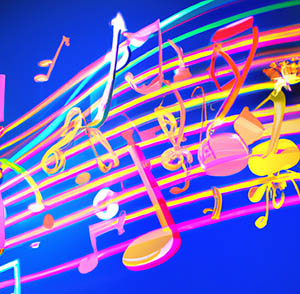Music Visualization: When Sound Meets Sight
Music is a universal language that transcends boundaries, connecting people from all walks of life. For many, it is a source of joy, inspiration, and healing. But for some individuals with synesthesia, music goes beyond just hearing sound – it becomes a visual experience.
Music visualization is a form of synesthesia in which an individual sees images, colors, or shapes in response to specific sounds or pieces of music. It is a type of audio-visual synesthesia that allows individuals to experience music in a unique and extraordinary way.

The Experience of Music Visualization
For individuals with music visualization synesthesia, listening to music is a multisensory experience. They not only hear the sounds of the music, but they also see colors, shapes, and patterns that are uniquely associated with different notes, instruments, or pieces of music.
For example, a person with music visualization synesthesia may see bright red and yellow colors when listening to upbeat pop music, while slow ballads might elicit soft blue and purple hues. Certain notes or chords may evoke specific shapes, such as triangles or circles, while others may create intricate patterns or textures.
The experience of music visualization is highly subjective and can vary from person to person. Some individuals may experience a full-blown visual display, while others may only see subtle flashes of color or shapes. The intensity and complexity of the visuals can also vary depending on the music being played, the individual's mood, and other contextual factors.
Understanding the Science of Music Visualization
The phenomenon of music visualization has long fascinated researchers, who are still working to uncover the underlying neural mechanisms that give rise to this unique form of synesthesia. While much remains unknown, current research suggests that music visualization is linked to the way that the brain processes sensory information.
According to a study published in the journal Cortex, music visualization synesthesia is associated with increased activity in brain regions involved in both auditory and visual processing. Specifically, researchers found that individuals with music visualization synesthesia showed greater activation in the visual cortex when listening to music, suggesting that their brains are able to integrate auditory and visual information in a unique way.
Another study published in the Journal of Neuroscience found that music visualization synesthesia is associated with a heightened sensitivity to sound, as well as greater connectivity between brain regions involved in auditory processing and those involved in visual imagery.
Applications of Music Visualization
While music visualization is still not well-understood, researchers are beginning to explore potential applications of this form of synesthesia in areas such as music therapy and education.
For example, some music therapists are incorporating music visualization techniques into their practice, using the visual imagery associated with specific songs or sounds to help patients relax, reduce stress, and manage pain. Other researchers are exploring how music visualization synesthesia might be used to enhance music education, by helping students develop a deeper appreciation for music and understand its structure and form in a more intuitive way.
Music visualization is also being explored as a potential tool for enhancing creative expression, both in music and other art forms. Some musicians and artists with music visualization synesthesia have reported that the visuals they experience while listening to music can inspire new creative ideas and spark new forms of artistic expression.
Challenges of Music Visualization
While music visualization can be a source of inspiration and wonder, it can also present unique challenges for individuals with this form of synesthesia. For some, the intense and often unpredictable visual imagery associated with music can be overwhelming or distracting, making it difficult to focus on other tasks or navigate everyday life.
This can create confusion or misunderstandings when trying to communicate about their experiences, or when sharing music with others who do not have synesthesia.